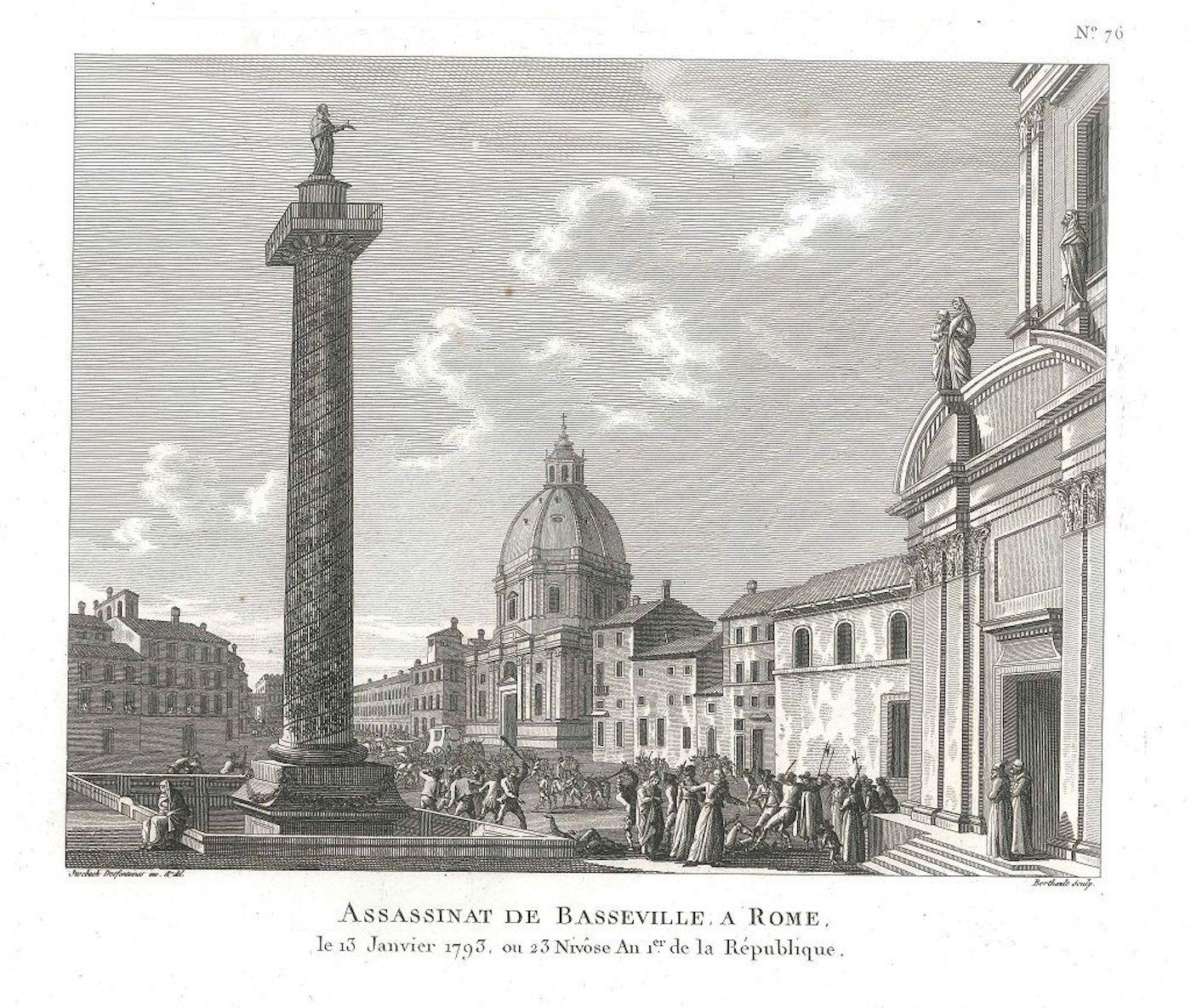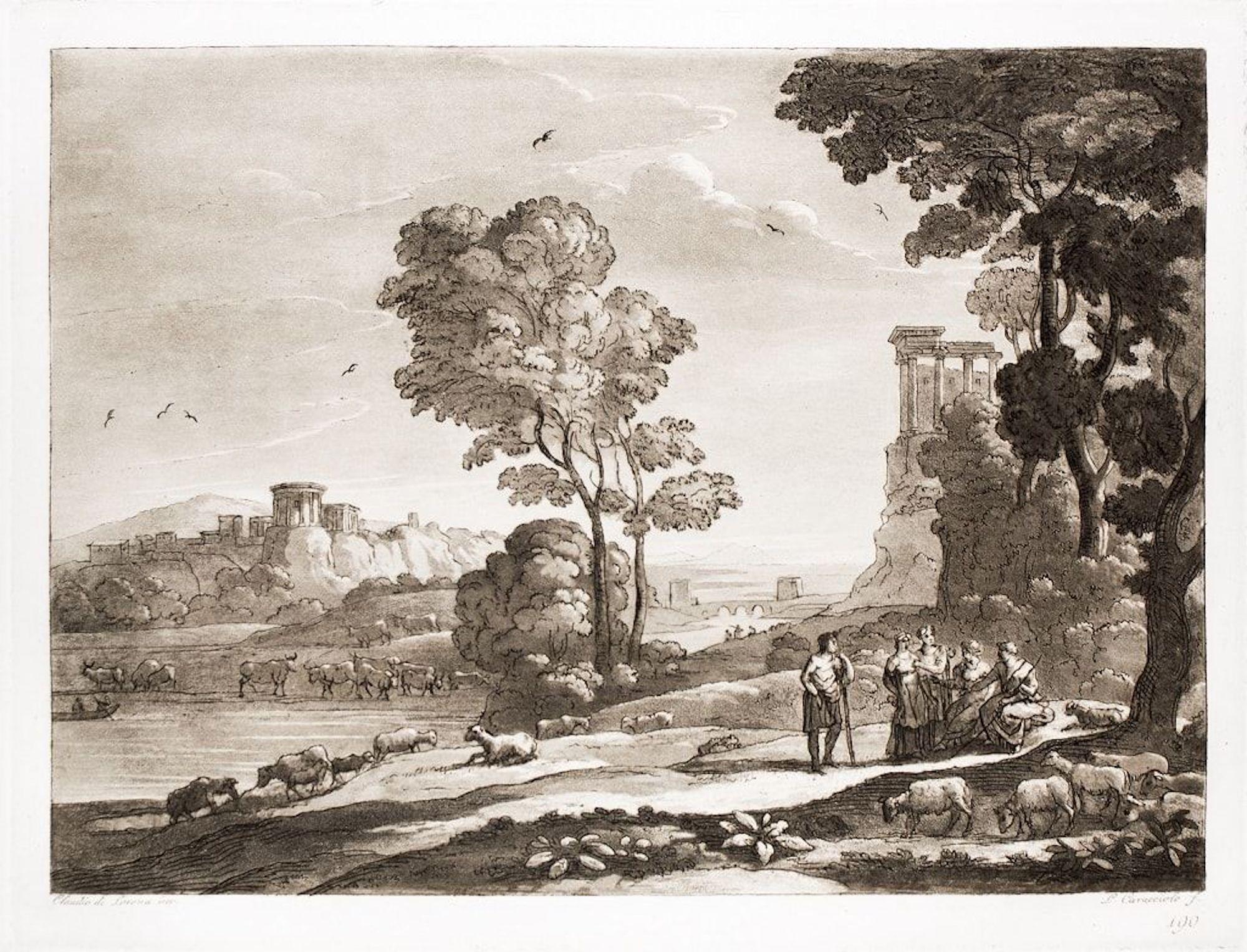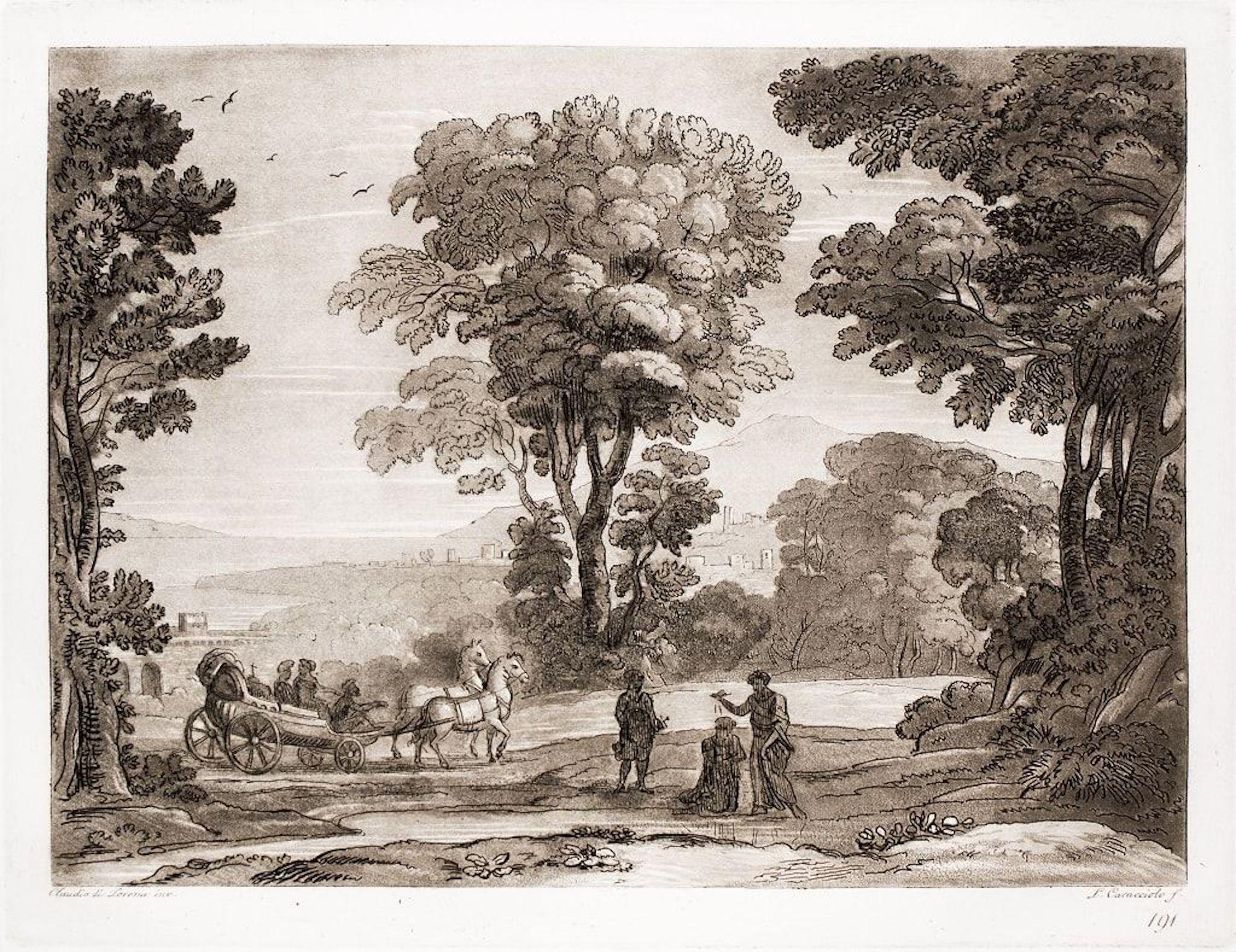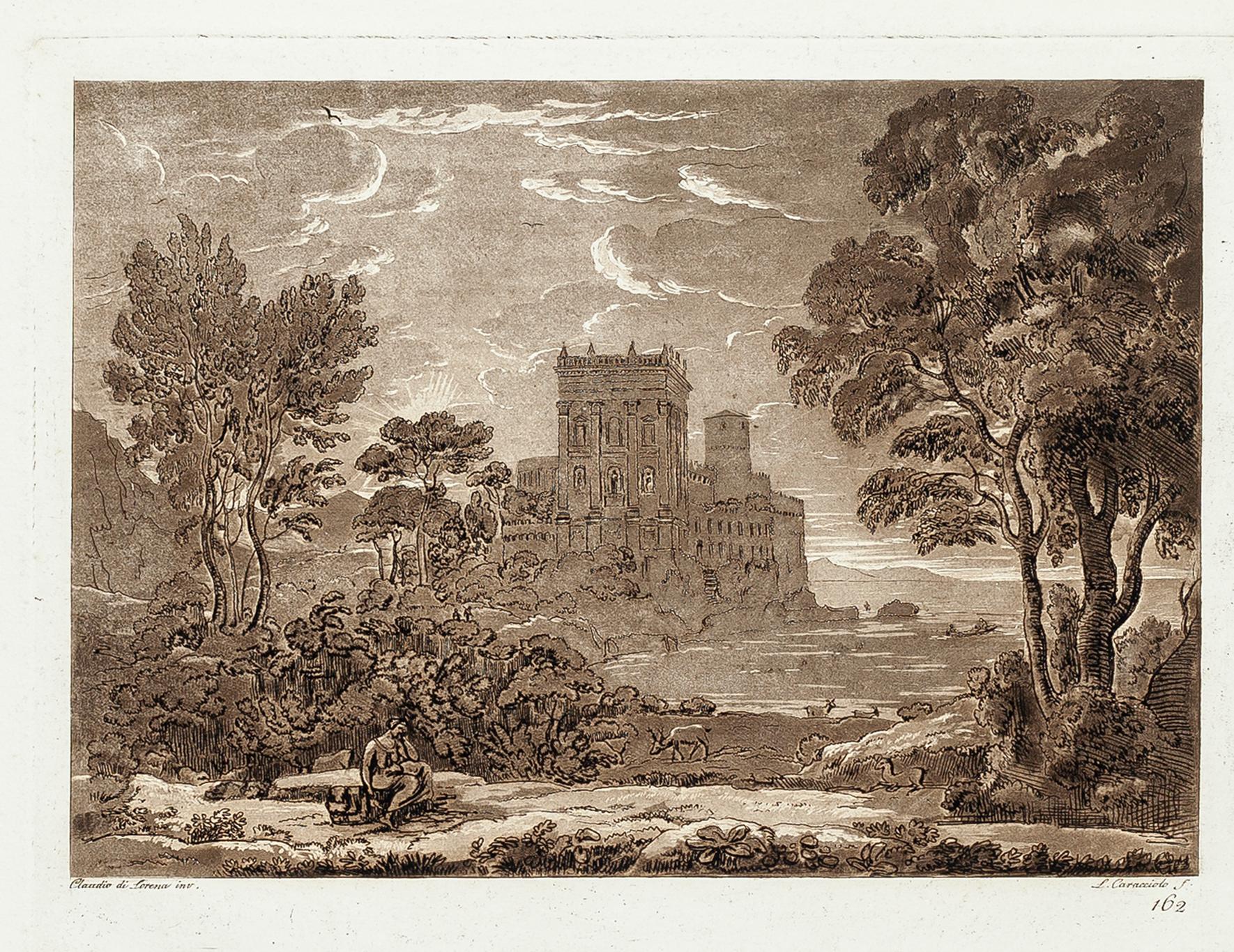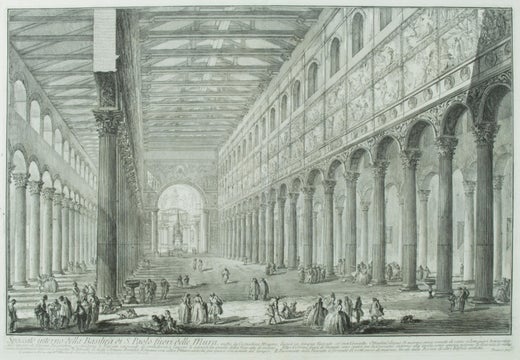Items Similar to XXXIII Fig. I Avanzo del Tempio di Castore e Polluce
Want more images or videos?
Request additional images or videos from the seller
1 of 6
Giovanni Battista PiranesiXXXIII Fig. I Avanzo del Tempio di Castore e Polluce 1756
1756
About the Item
XXXIII Fig. I Avanzo del Tempio di Castore e Polluce .View of the Remains of the Peristyle of the House of Nero,
Etching, 1756
Signed in the plate (see photo)
From: Le Antichità Romane (Roman Antiquity), 1756-1757, Four Volumes
From the first edition, printed in Roma, 1758
Publisher: Angelo Rotili
Watermark: Double Circle Fleur de Lys
Inscription: At upper left: Fig. XXXVI
At bottom center: Veduta dell' Avanzo del Peristilo della Casa Neroniana
At lower right: Piranesi Archit. dis. inc.
Condition: Excellent
Plate/Image size: 5 1/8 x 7 5/8 inches
Sheet size: 8 3/4 x 11 5/8 inches
Reference: Focillon 20.A.213
Wilton_Ely 392.348
Provenance: Dale Zimmerman (1928=2021), noted artist and collector
“Piranesi spent his first few years in Rome measuring and sketching ancient architectural sites. The results of Piranesi’s comprehensive research were presented in the four volumes of the Antichità Romane (1756). This production rapidly earned Piranesi an international reputation, as evidenced by his election to the Honorary Fellowship of the Society of Antiquaries of London a year later. Antichità Romane itself set out to provide a sweeping overview of the archaeological information on Ancient Rome Piranesi gathered over the years. Its purpose was the education of contemporary designers and their patrons. The more than 250 images feature original methods of illustration, combining an impressive amount of data and skilled etchings into a single plate. As depicted in the views of the burial chamber and tomb, Piranesi balances the picturesque appearance of Roman architecture with detailed explanatory text in one plate. Piranesi’s expansive topographical knowledge of Rome allowed him to place the many diverse and isolated ancient remains into the broader context of Rome’s new urban development. 21 The Antichità Romane represented a milestone in the history of classical archaeology, a newly established area of study for historians. Classical archaeology became popular, or valued, after the discovery of Pompeii and Herculaneum, sites that piqued the interest of many intellectuals and aristocrats. Besides representing a massive advance in the how archaeological discoveries were communicated to the broader public, the Antichità Romane focused attention in a visually stunning way to neglected aspects of antiquity, such as the techniques of Roman building science and non-traditional Roman decoration. The Antichità Romane was set apart from the work of Piranesi’s peers due to the greater spectrum of buildings he included in the work and by the way he placed them within landscape settings, often with the addition of figures. The figures within Piranesi’s etchings often hint towards the sublime, an art style defined by the seemingly overwhelming terror of nature looming over mankind. In the early 18th century, nature was determined to be a devastating force that needed to be controlled; control over nature represented the control one had over man. The sublime was introduced as philosophers and intellectuals from France and Britain came to see that the overwhelming powers of nature were, in a way, beautiful, because of the pure terror and emotion it incited in viewers. Piranesi’s miniscule figures and grand, vast structures represent the relationship people of the 18th century believed they had with nature and ancient ruins. The Antichità Romane, and his sublime images of ruins, allowed Piranesi to make a name for himself as an antiquarian.” Courtesy: Wellesley Davis Museum of Art
- Creator:Giovanni Battista Piranesi (1720-1778, Italian)
- Creation Year:1756
- Dimensions:Height: 5.13 in (13.04 cm)Width: 7.63 in (19.39 cm)
- Medium:
- Movement & Style:
- Period:1750-1759
- Condition:
- Gallery Location:Fairlawn, OH
- Reference Number:
Giovanni Battista Piranesi
Piranesi was born in Venice in 1720 and died in Rome in 1778. He was the son of a stone mason and was trained as an architect. After a slow start he eventually achieved great success as an architect, archaeologist, artist, designer, collector, and antiquities dealer. His mission was to glorify the architecture of ancient Rome through his engravings and etchings. His highly dramatized prints often depict imaginary interiors and frequently include figures in mysterious activities, who are dwarfed by the magnitude of their monumental surroundings. Piranesi's style greatly influenced the neoclassical art movement of the late 18th century. His dramatic scenes inspired generations of set designers, as well as artists, architects and writers. His prints have continued to increase in value to institutions and collectors.
About the Seller
5.0
Recognized Seller
These prestigious sellers are industry leaders and represent the highest echelon for item quality and design.
Platinum Seller
These expertly vetted sellers are 1stDibs' most experienced sellers and are rated highest by our customers.
Established in 1978
1stDibs seller since 2013
714 sales on 1stDibs
Typical response time: 1 hour
Associations
International Fine Print Dealers Association
- ShippingRetrieving quote...Ships From: Fairlawn, OH
- Return PolicyA return for this item may be initiated within 10 days of delivery.
More From This SellerView All
- The Monumental TabletBy Giovanni Battista PiranesiLocated in Fairlawn, OHThe Monumental Tablet Etching, engraving, drypoint and burnishing, c. 1748 Series: Grotteschi (Grotesques, 4 plates) Original, unwashed condition. Excellent. Second edition first is...Category
1740s Old Masters Prints and Multiples
MaterialsEtching
- Scene II, Le Nozze Degli DeiBy Stefano Della BellaLocated in Fairlawn, OHScene II, Le Nozze Degli Dei Etching, 1637 Signed in the plate lower left The scene depicts the initial moment when Diana is revealed, surrounded by her nymphs, celebrating a success...Category
1630s Old Masters Landscape Prints
MaterialsEtching
- View of the Ancient Structure built by Tarquinius Superbus called the Bel LidoBy Giovanni Battista PiranesiLocated in Fairlawn, OHView of the Ancient Structure built by Tarquinius Superbus called the Bel Lido, and like others built by Marcus Agrippa in the time of Augustus when he ...Category
1750s Old Masters Landscape Prints
MaterialsEtching
- The Ponte and Castel S. Angelo (Veduta del Ponte e Castello Sant' Angelo)By Giovanni Battista PiranesiLocated in Fairlawn, OHThe Ponte and Castel S. Angelo Veduta del Ponte e Castello Sant' Angelo Etching, 1754 Signed in the plate lower right above the caption From: Vedute di Roma A proper Roman printing with the price in the lower right corner. Printed on a Double Circle Fleur de Lys watermark paper, c. 1760, with full margins. A brilliant impression . Note: A view of the Tiber River, Castello Sant' Angelo and St. Peter's Basilica in the distance. Watermark: Double Circle Fleur de Lys References: Robison c/g Hind 29 ii/VII Foclllon 793 Condition: A Roman printing before the numbers added in Paris. Printed on a Double Circle Fleur-de-Lys watermark paper. Right margin folded over 5/8 inches for framing. Usual centerfold as issued in the album. Slight aging to the sheet. Binding holes at the left margin edge Framed with plexi. Plate size: 14 7/8 x 22 7/8 inches Sheet size: 21 5/8 x 30 5/16 inches Frame size: 22 3/4 x 33 1/2 inches Sant’Angelo Bridge, Italian Ponte Sant’Angelo, ancient (Latin) Pons Aelius, ancient Roman bridge, probably the finest surviving in Rome itself, built over the Tiber by the emperor Hadrian (reigned 117–138 AD) to connect the Campus Martius with his mausoleum (later renamed Castel Sant’Angelo). The bridge was completed about AD 135. It consists of seven stone arches and five main spans of about 60 feet (18 m) each, supported on piers 24 feet (7 m) high. In the 13th century Pope Clement IV installed an iron balustrade and in the 16th century Pope Clement VII placed statues of Saints Peter and Paul...Category
1750s Old Masters Landscape Prints
MaterialsEtching
- Veduta dell'esterno della gran Basilica di S. Pietro in VaticanoBy Giovanni Battista PiranesiLocated in Fairlawn, OHVeduta dell'esterno della gran Basilica di S. Pietro in Vaticano (View of the Exterior of St. Peter's Basilica in the Vatican) Etching, 1748 From the first printing of the "Vedute di...Category
1740s Old Masters Landscape Prints
MaterialsEtching
- The Arch of Constantine and the ColosseumBy Giovanni Battista PiranesiLocated in Fairlawn, OHThe Arch of Constantine and the Colosseum Vedute dell' Arco di Costantino, e dell' Anfiteatro Flavio il Colosseo From: "Vedute di Roma" (Roman Views), part II An early Paris edition,...Category
1760s Old Masters Landscape Prints
MaterialsEtching
You May Also Like
- Assassinat de Basseville à Rome - Original Etching by P.G. Berthault - 1793By Pierre Gabriel BerthaultLocated in Roma, ITAssassinat De Basseville à Rome is an original black and white etching realized by Pierre Gabriel Berthault, after Jacques François Joseph Swebach-Desfontaines in 1793. Title with caption on plate on the lower center: "Assassinat de Basseville, à Rome/ le 13 Janvier 1793, ou 23 Nivose An Ier de la République". Below the image on the lower margin, "Swebach Desfontaines onv. et del. / Berthault sculp." is etched on plate. This modern artwork is numbered "N. 76", because it is from the series Les Tableaux historiques de la Révolution française. As a matter of fact, Pierre-Gabriel Berthault is well-known for having engraved plates from this collection with the collaboration of the engraver Jean Duplessis-Bertaux. A work - hanging in the balance between news and history - with illustrations of salient or minimal events occurred during the French Revolution. As a celebration of the new ideals of brotherhood, justice, and equality, Les Tableaux immediately became a point of reference for journalism at the time. Of traditional cut, namely showing a view with many human figures, the engraving simplified the lines to be immediately readable for the general public. In our specific case, this original print represents the murder of Hugou de Bassville or Basseville (7 February, 1743 – 13 January, 1793), a French journalist and diplomatist, and protector of the radical Jacobins in Rome. In excellent conditions, except for a usual yellowing of the paper on the edges and a light trace of oxidations on the lower and right margins, beyond the marginal line of the matrix. Pierre-Gabriel Berthault (Saint-Maur-des-Fossés, 1737 - Paris, 1831) was a French master who made engravings from drawings by Jean-Claude Richard de Saint-Non (known as the Abbot of Saint-Non) and from paintings by Louis François Cassas. He depicted many views of Italy and created the collections Voyage à Naples and Voyage pittoresque de la Syrie, de la Palestine et de la basse-Egypte. Before the French Revolution, he was famous for being the author of the Vues intérieures de Paris and for tables with architectural elevations.Category
1790s Old Masters Landscape Prints
MaterialsEtching
- The Passengers - Original Etching by A. M. de Ghuy - 1775Located in Roma, ITThe Passenger is an original artwork realized by Antoine de Marcenay de Ghuy in 1775. Original etching on paper. Titled on the lower margin at the center. The artwork is glued on ca...Category
1770s Old Masters Landscape Prints
MaterialsEtching
- Liber Veritatis - Original B/W Etching after Claude Lorrain - 1815By Ludovico CaraccioloLocated in Roma, ITImage dimensions: 21 x 27 cm. Liber Veritatis - Plate 190 is a beautiful black and white etching and aquatint on paper realized by the Italian artist Ludovico Caracciolo, after Clau...Category
1810s Old Masters Figurative Prints
MaterialsAquatint, Etching
- Liber Veritatis - Original B/W Etching after Claude Lorrain - 1815By Ludovico CaraccioloLocated in Roma, ITImage dimensions: 21 x 27 cm. Liber Veritatis - Plate 191 is a beautiful black and white etching and aquatint on paper realized by the Italian artist ...Category
1810s Old Masters Figurative Prints
MaterialsAquatint, Etching
- Les Trois Pilons du Carbet / Fort Royal - Original Etching - 19th centuryLocated in Roma, ITLandscape is an original etching on paper realized in 19th Century. Printed in series of "France Pittoresque" at the top center. Titled in France on the lower center. Included two...Category
19th Century Old Masters Landscape Prints
MaterialsEtching
- Landscape fromLiber Veritatis - Original B/W Etching after Claude Lorrain - 1815By Ludovico CaraccioloLocated in Roma, ITImage dimensions: 21 x 27 cm. Liber Veritatis - Plate 162 is a beautiful black and white etching and aquatint on paper realized by the Italian artist Ludovico Caracciolo, after Clau...Category
1810s Old Masters Figurative Prints
MaterialsAquatint, Etching
